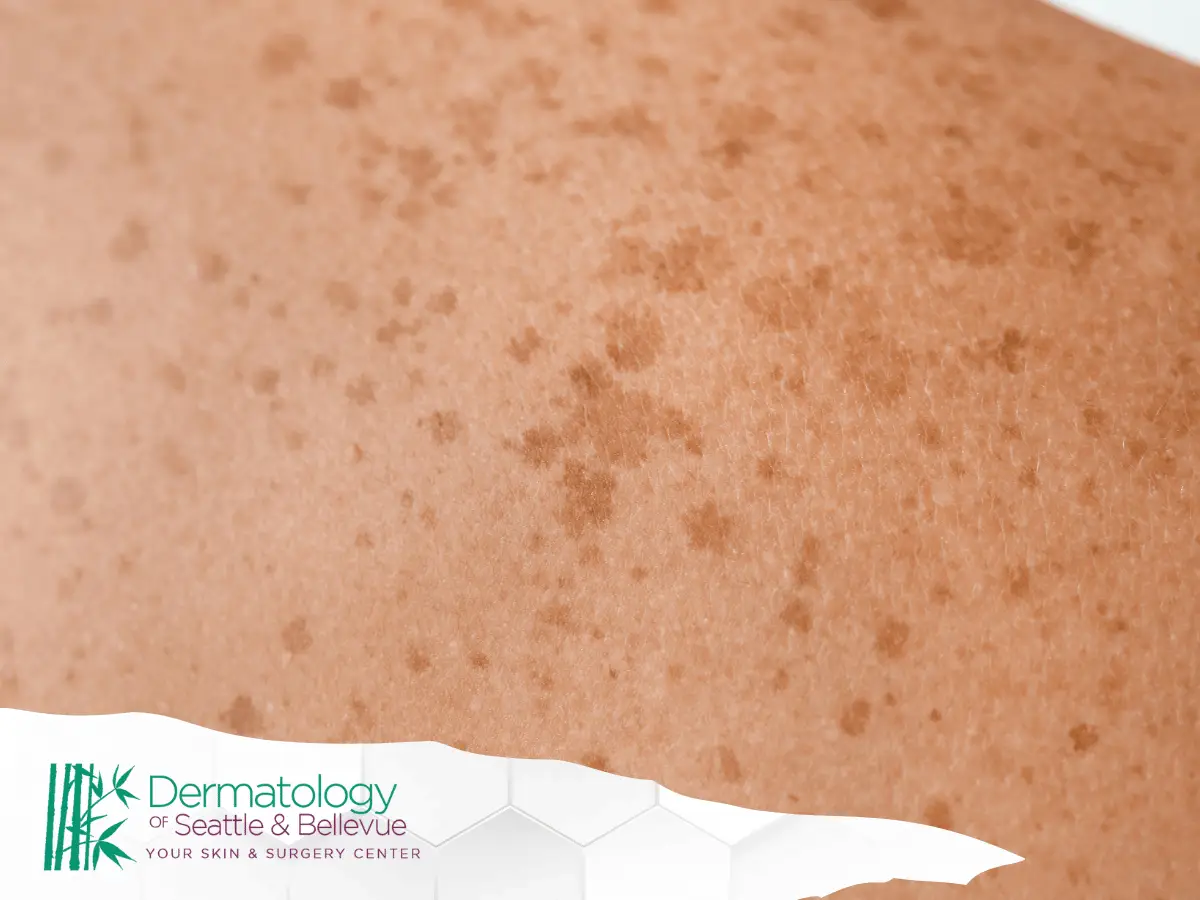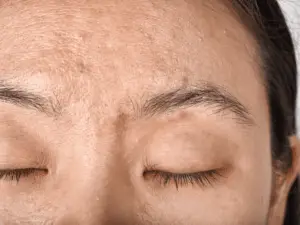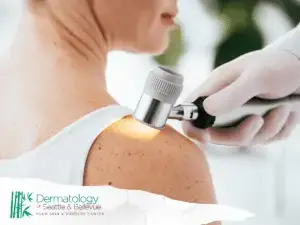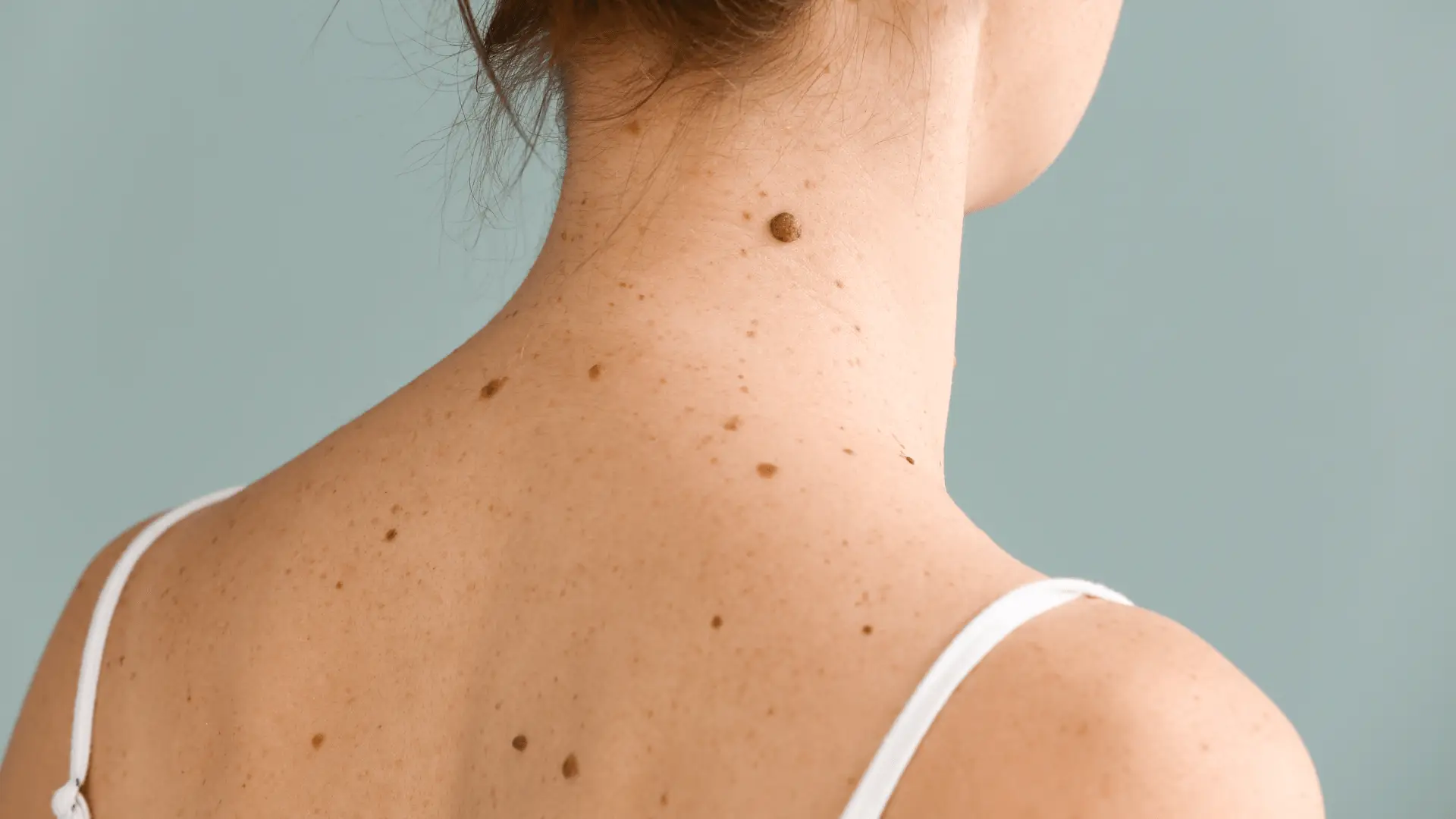It’s a common belief that skin cancer only develops in areas that receive regular sun exposure—like the face, neck, arms, or back. But can you get skin cancer on areas not exposed to the sun? The short answer is yes. While ultraviolet rays from the sun or tanning beds are leading culprits, cancer can still form in parts of the skin that rarely, if ever, see the light of day.
Quick Summary
- Skin cancer can develop on non-sun-exposed areas like soles, palms, under nails, groin, buttocks, and scalp.
- UV exposure is a major cause, but genetics, radiation, chemicals, chronic inflammation, and immune suppression also raise risk.
- Melanoma can appear on palms/soles, under nails, or mucosal tissue; SCC and BCC can also occur in hidden areas.
- Hidden-site cancers are often found later due to missed checks, increasing the chance of spread and more intensive treatment.
- Do monthly full-body self-exams and use year-round sun protection; see a dermatologist for any new or changing lesions.
This article explores how skin cancer develops in hidden places, the risk factors involved, and how to protect your health, even when your skin isn’t exposed to sunlight.
Overview
Understanding how skin cancer forms—and where—is key to taking control of your skin health. While sun exposure remains the top cause of skin cancer, there’s more to the story. Genetics, immune conditions, and even certain types of chemical exposure can also increase your risk.
In this section, we’ll explore the basic biology behind skin cancer and how UV rays factor into the equation, so you have a clear picture of what’s happening beneath the surface.
Skin cancer basics
Skin cancer happens when skin cells grow uncontrollably, often due to mutations caused by DNA damage. This can stem from harmful UV rays, but other factors—like radiation exposure or genetic conditions—can trigger the same abnormal behavior in cells.
There are three main types of skin cancer:
- Basal cell carcinoma – the most common and typically slow-growing
- Squamous cell carcinoma – more aggressive and can spread
- Melanoma – the deadliest form, developing in the melanocytes (the pigment-producing cells of the skin)
Each form carries different symptoms, treatments, and levels of cancer risk, but all three can develop in both sun-exposed and hidden areas of the body.
Sun exposure and skin cancer risk
Sun exposure is one of the most well-documented risk factors for developing skin cancer, particularly on areas that are regularly exposed to ultraviolet rays. The DNA damage caused by UV rays from the sun or artificial sources like tanning beds can lead to mutations in skin cells, which may eventually result in cancer.
Repeated sunburn, especially during childhood, significantly increases your skin cancer risk later in life. That’s why protecting the skin with sunscreen, shade, and protective clothing is essential even on overcast days or in the winter, when UV exposure is still present.
Non-sun-exposed areas
It may seem surprising, but skin cancer can and does develop on parts of the body that aren’t typically exposed to the sunlight. Areas like the soles of the feet, palms, under the nails, buttocks, or even the genital region can be affected.
These non-sun-exposed regions are often overlooked during regular skin checks, which can delay detection. That’s why it’s important to understand the risks and pay attention to signs anywhere on the skin, not just in places that see the sun.
Explanation of non-sun-exposed areas
When we think of sun exposure, we picture the face, arms, and shoulders. But many body parts remain consistently covered—yet they’re still vulnerable to skin cancer. These areas include:
- Groin and genital region
- Soles of the feet
- Underarms
- Beneath nails (subungual regions)
- Buttocks
- Scalp (especially under thick hair)
Cancer in these regions can arise due to genetic mutations, chronic inflammation, harmful chemicals, or autoimmune conditions—not just from tanning or UV rays.
Can skin cancer develop on non-sun-exposed areas?
Yes—skin cancer can absolutely form on non-sun-exposed areas. While less common, it does happen, and sometimes these cases are even more dangerous due to delayed diagnosis. Since many people don’t expect cancer in these hidden spots, they often overlook changes or dismiss symptoms until the disease has progressed.
For example, melanoma on the soles of the feet or under a nail may not be detected until it has already started to spread. That’s why awareness is so critical—even for the parts of your skin you don’t see every day.
Types of skin cancer that can affect non-sun-exposed areas
Although all types of skin cancer can potentially appear in hidden regions, some are more likely to do so than others:
- Melanoma: Can form in mucosal tissue, under nails, or on the soles and palms—areas with little to no sun exposure
- Squamous cell carcinoma: May develop in areas affected by chronic inflammation or chemical exposure
- Basal cell carcinoma: Though typically linked to UV rays, it can sometimes occur in less exposed parts of the skin
These rare presentations still carry significant cancer risk and often require the same aggressive treatments as their sun-exposed counterparts.
Risk factors
Your chances of developing skin cancer—even in areas shielded from the sun—can be influenced by a range of risk factors beyond just sunlight. These include genetic predispositions, chemical exposure, immune system challenges, and lifestyle elements like tanning habits.
Understanding what increases your cancer risk helps you make better decisions for long-term health and encourages vigilance across all areas of the skin, not just the visible ones.
Genetics and skin cancer risk
Your genes can play a major role in your overall skin cancer risk. If you have a family history of melanoma, basal cell carcinoma, or squamous cell carcinoma, your chances of developing the disease increase—regardless of your level of sun exposure.
Inherited conditions like xeroderma pigmentosum, which impairs the skin’s ability to repair DNA damage, can make people significantly more vulnerable to cancer, even in non-sun-exposed areas. Knowing your genetic background can help guide more frequent regular skin checks and early screening by a dermatologist.
Environmental factors
Not all skin cancers are caused by sunlight or UV rays. Exposure to harmful chemicals, such as arsenic, and certain industrial compounds can also trigger abnormal skin cell growth. Prolonged radiation exposure, whether from medical treatments or the environment, has been linked to both carcinomas and melanoma. Additionally, genetic predispositions can play a significant role in the development of skin cancers, making some individuals more susceptible regardless of their sun exposure. While many people focus on the importance of sunscreen and skin cancer risks associated with UV radiation, it’s crucial to be aware of other environmental and genetic factors that contribute to this health issue. Regular screenings and awareness of unusual skin changes are important for early detection and treatment.
Living in polluted environments, working in chemical-heavy industries, or experiencing chronic inflammation or injury to the skin can all increase cancer risk, even in areas the sun never touches.
Other risk factors for skin cancer development
A few more factors that may contribute to developing skin cancer on hidden parts of the body include:
- A weakened immune system, especially after organ transplant or in those with HIV/AIDS
- Certain viral infections, such as HPV, which have been linked to rare forms of cancer
- Prolonged use of tanning beds, which can affect areas not directly targeted by the light but still absorb UV rays
Even seemingly harmless routines—like skipping sunscreen in the winter or assuming indoor tanning is safe—can carry long-term health consequences for your skin.
Prevention and early detection
While you can’t change your genetics, many cases of skin cancer—including those in non-sun-exposed areas—can be caught early or even prevented. Combining proactive habits with regular checkups plays a critical role in preserving long-term skin health.
Even when sun exposure isn’t the main culprit, staying alert to new or changing marks on your skin and maintaining a strong sun protection routine can make all the difference.
Importance of regular skin checks
Regular skin checks are one of the most effective tools for early detection. These self-exams, ideally done once a month, should include the full body—not just the obvious areas like the face, arms, and legs.
Key tips for effective checks:
- Use a full-length mirror and a handheld mirror to check all angles
- Don’t forget hidden areas like the scalp, soles, underarms, and between the toes
- Look for new moles, or changes in color, size, or shape of existing ones
- Keep an eye on any pigment lines or dark streaks in or around the nails
If something looks suspicious or unfamiliar, schedule an appointment with a dermatologist promptly.
Sun protection measures for all areas of the body
Even though this post focuses on non-sun-exposed areas, protecting your entire skin from sunlight remains vital. Sunscreen should be a non-negotiable part of your daily routine, no matter the season.
- Use SPF 30 or higher with ultraviolet protection factor (UPF) clothing
- Reapply sunscreen every 2 hours when outdoors or after swimming/sweating
- Wear protective clothing, hats, and sunglasses—even in winter
- Avoid tanning beds, which emit concentrated UV rays
Daily prevention supports better skin health and reduces your overall cancer risk.
Treatment options
When skin cancer is diagnosed in a non-sun-exposed area, the approach to treatment is generally the same as it would be for more typical locations. However, due to the sensitive nature or location of these areas, additional care is often required to ensure both effective results and patient comfort.
Early detection remains a key factor in determining how invasive the treatment will need to be and how well the patient responds.
Treatment options for skin cancer on non-sun-exposed areas
Treatments vary depending on the type of skin cancer, its size, depth, and location, but the most common options include:
- Surgical excision – removal of the cancerous tissue and surrounding area
- Mohs surgery – especially useful for precise removal in delicate or high-risk areas
- Radiation therapy – used when surgery isn’t ideal
- Topical treatments – creams or gels for certain superficial carcinomas
- Immunotherapy or chemotherapy – more common in advanced or metastatic melanoma
Because non-sun-exposed cancers are often diagnosed later, a multi-step treatment plan may be needed. That’s why regular screening with a dermatologist is so crucial.
Importance of early detection in treatment success
The success of any cancer treatment hinges on catching it early. This is especially true for melanoma, which can spread quickly to other parts of the body if not addressed in time. The earlier you detect an abnormality, the less invasive the treatment is likely to be—and the better the outcome.
That’s why the message is simple: check all of your skin, not just the areas you think are at risk.
Conclusion
So, can you get skin cancer on areas not exposed to the sun? Yes—and while less common, these cases can be just as serious. Sun exposure may be the primary cause of skin cancer, but it’s far from the only one. Genetic conditions, environmental factors, and even tanning practices all play a role in increasing your overall cancer risk. Additionally, certain medications can make the skin more sensitive to UV light, increasing the risk of skin cancer even in areas typically shielded from the sun. It’s important to be aware of skin cancer causes beyond sunburn, as early detection is crucial for effective treatment. Regular check-ups and self-examinations can help identify any unusual changes in the skin that may indicate a problem.
Whether you’re monitoring visible moles or examining hidden areas, your vigilance could be life-saving. Take time for regular skin checks, protect your skin year-round, and speak with a dermatologist if you have any concerns. Your health is always worth the effort.








